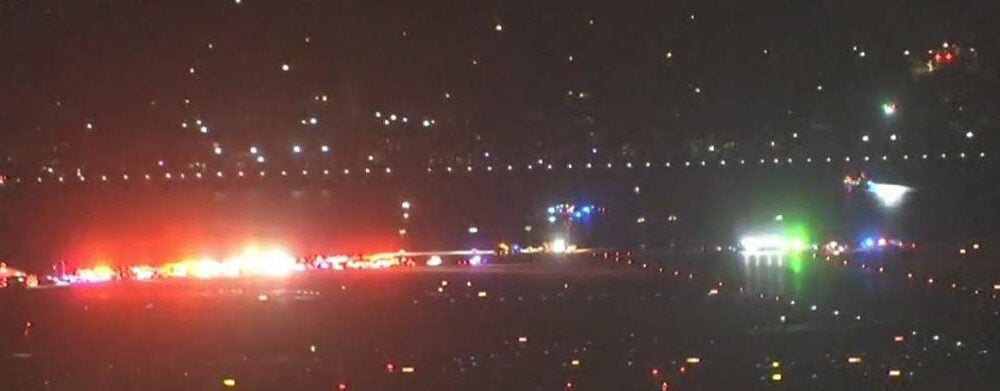American Airlines Jet Collides with US Army Black Hawk Near Reagan Airport, Sparking Major Rescue Operation in Potomac River
A serious mid-air collision occurred on Wednesday night, January 29, 2025, when an American Airlines passenger jet crashed into a US Army UH-60 Black Hawk helicopter near Ronald Reagan National Airport in Washington, D.C. The impact caused both aircraft to plummet into the Potomac River, triggering an urgent emergency response from multiple agencies, including the Federal Aviation Administration (FAA), the National Transportation Safety Board (NTSB), and the Metropolitan Police Department.
American Airlines Flight 5342, operated by PSA Airlines, was carrying 60 passengers and four crew members and had departed from Wichita, Kansas, en route to Washington, D.C. The Black Hawk helicopter, widely used for military operations and high-level transport, was carrying three soldiers at the time of the collision. So far, there have been no confirmed casualties, but search and rescue operations are ongoing in the freezing waters of the Potomac.
Eyewitness accounts describe the harrowing moment when the two aircraft collided. One witness, Ari Schulman, reported seeing the jet banking sharply to the right just seconds before impact, followed by a bright yellow flash and a shower of sparks. Experts suggest that this maneuver could have been an attempt by the pilot to avoid the collision.
Details of the Aircraft Involved
Flight 5342 was a Bombardier CRJ700, a regional jet known for its reliability and efficiency in short- and medium-haul routes. The aircraft departed from Wichita, a major aviation hub, and was approaching Reagan Airport when the accident occurred.
The UH-60 Black Hawk, manufactured by Sikorsky, is a versatile military helicopter used for combat, logistics, and medical evacuations. The aircraft involved in the crash was not carrying VIP personnel and was reportedly on a routine flight near the nation’s capital.
Circumstances of the Collision and Initial Investigations
The collision happened at approximately 8:53 p.m. local time, just as Flight 5342 was preparing to land at Reagan Airport. The FAA and NTSB have launched a full investigation into the incident, focusing on air traffic control communication, possible mechanical failures, and weather conditions.
Early reports indicate that visibility was poor at the time of the crash, which may have contributed to the accident. Investigators will also analyze black box recordings and radar data to determine whether human error, technical malfunction, or miscommunication played a role.
Emergency Response and Rescue Efforts
Following the collision, emergency teams swiftly mobilized to the crash site. The Washington, D.C. Fire and Emergency Medical Services Department, the U.S. Coast Guard, and the Metropolitan Police Department coordinated efforts to locate potential survivors and recover debris.
Rescue teams faced significant challenges due to the near-freezing temperatures of the Potomac River, which was recorded at approximately 35°F (1.6°C). Cold shock and hypothermia pose serious risks to anyone exposed to such conditions. According to the National Weather Service:
- Loss of hand function occurs within 3 to 5 minutes
- Hypothermia can set in within 15 minutes
- Unconsciousness may occur between 15 to 30 minutes
- Estimated survival time ranges from 30 to 90 minutes
Given these extreme conditions, the speed of rescue operations will be critical in determining survival outcomes.
Impact on Reagan Airport Operations and Government Response
Following the crash, Reagan National Airport temporarily suspended all arrivals and departures, causing significant disruptions. Stranded passengers were accommodated with alternative transportation, including buses and extended Metro service.
U.S. Secretary of Defense Pete Hegseth confirmed that the Department of Defense was actively monitoring the situation. President Donald Trump was also briefed on the incident and is receiving regular updates from federal agencies. Kansas Governor Laura Kelly issued a statement expressing concern and solidarity, as Flight 5342 had originated from Wichita.
Potential Causes and History of Similar Incidents
While the exact cause of the collision remains under investigation, aviation experts have identified several possible contributing factors:
- Failure in air traffic control coordination
- Pilot misjudgment or human error
- Technical malfunction in navigation systems
- Low visibility due to weather conditions
- The helicopter operating outside designated airspace
Mid-air collisions involving commercial jets and military aircraft are rare but not unprecedented. In 2002, a DHL Boeing 757 collided with a Russian cargo plane over Germany due to miscommunication between pilots and air traffic controllers. In 2018, a U.S. Air Force F-16 crashed into a civilian Cessna 150 in California, resulting in fatalities.
Extreme Water Temperatures Increase Survival Risks
A major concern for rescue operations is the frigid temperature of the Potomac River. The National Weather Service issued a warning about the dangers of sudden immersion in cold water, which can lead to immediate physiological distress.
Sudden exposure to water below 40°F (4°C) can cause:
- Rapid loss of muscle function
- Uncontrollable gasping and hyperventilation
- Increased heart rate and risk of cardiac arrest
- Complete loss of mobility within minutes
These factors make rapid rescue efforts essential to preventing fatalities.
Ongoing Investigation and Next Steps
As the search continues, investigators will focus on recovering the black boxes from both aircraft. These flight recorders will provide crucial data on pilot communications, flight paths, and potential technical failures.
The crash has raised concerns over airspace management in Washington, D.C., particularly given the frequent movement of both commercial and military aircraft. Authorities will likely reassess safety protocols to prevent similar incidents in the future.

A serious mid-air collision occurred on Wednesday night, January 29, 2025, when an American Airlines passenger jet crashed into a US Army UH-60 Black Hawk helicopter near Ronald Reagan National Airport in Washington, D.C. The impact caused both aircraft to plummet into the Potomac River, triggering an urgent emergency response from multiple agencies, including the Federal Aviation Administration (FAA), the National Transportation Safety Board (NTSB), and the Metropolitan Police Department.
American Airlines Flight 5342, operated by PSA Airlines, was carrying 60 passengers and four crew members and had departed from Wichita, Kansas, en route to Washington, D.C. The Black Hawk helicopter, widely used for military operations and high-level transport, was carrying three soldiers at the time of the collision. So far, there have been no confirmed casualties, but search and rescue operations are ongoing in the freezing waters of the Potomac.
Eyewitness accounts describe the harrowing moment when the two aircraft collided. One witness, Ari Schulman, reported seeing the jet banking sharply to the right just seconds before impact, followed by a bright yellow flash and a shower of sparks. Experts suggest that this maneuver could have been an attempt by the pilot to avoid the collision.
Details of the Aircraft Involved
Flight 5342 was a Bombardier CRJ700, a regional jet known for its reliability and efficiency in short- and medium-haul routes. The aircraft departed from Wichita, a major aviation hub, and was approaching Reagan Airport when the accident occurred.
The UH-60 Black Hawk, manufactured by Sikorsky, is a versatile military helicopter used for combat, logistics, and medical evacuations. The aircraft involved in the crash was not carrying VIP personnel and was reportedly on a routine flight near the nation’s capital.
Circumstances of the Collision and Initial Investigations
The collision happened at approximately 8:53 p.m. local time, just as Flight 5342 was preparing to land at Reagan Airport. The FAA and NTSB have launched a full investigation into the incident, focusing on air traffic control communication, possible mechanical failures, and weather conditions.
Early reports indicate that visibility was poor at the time of the crash, which may have contributed to the accident. Investigators will also analyze black box recordings and radar data to determine whether human error, technical malfunction, or miscommunication played a role.
Emergency Response and Rescue Efforts
Following the collision, emergency teams swiftly mobilized to the crash site. The Washington, D.C. Fire and Emergency Medical Services Department, the U.S. Coast Guard, and the Metropolitan Police Department coordinated efforts to locate potential survivors and recover debris.
Rescue teams faced significant challenges due to the near-freezing temperatures of the Potomac River, which was recorded at approximately 35°F (1.6°C). Cold shock and hypothermia pose serious risks to anyone exposed to such conditions. According to the National Weather Service:
- Loss of hand function occurs within 3 to 5 minutes
- Hypothermia can set in within 15 minutes
- Unconsciousness may occur between 15 to 30 minutes
- Estimated survival time ranges from 30 to 90 minutes
Given these extreme conditions, the speed of rescue operations will be critical in determining survival outcomes.
Impact on Reagan Airport Operations and Government Response
Following the crash, Reagan National Airport temporarily suspended all arrivals and departures, causing significant disruptions. Stranded passengers were accommodated with alternative transportation, including buses and extended Metro service.
U.S. Secretary of Defense Pete Hegseth confirmed that the Department of Defense was actively monitoring the situation. President Donald Trump was also briefed on the incident and is receiving regular updates from federal agencies. Kansas Governor Laura Kelly issued a statement expressing concern and solidarity, as Flight 5342 had originated from Wichita.
Potential Causes and History of Similar Incidents
While the exact cause of the collision remains under investigation, aviation experts have identified several possible contributing factors:
- Failure in air traffic control coordination
- Pilot misjudgment or human error
- Technical malfunction in navigation systems
- Low visibility due to weather conditions
- The helicopter operating outside designated airspace
Mid-air collisions involving commercial jets and military aircraft are rare but not unprecedented. In 2002, a DHL Boeing 757 collided with a Russian cargo plane over Germany due to miscommunication between pilots and air traffic controllers. In 2018, a U.S. Air Force F-16 crashed into a civilian Cessna 150 in California, resulting in fatalities.
Extreme Water Temperatures Increase Survival Risks
A major concern for rescue operations is the frigid temperature of the Potomac River. The National Weather Service issued a warning about the dangers of sudden immersion in cold water, which can lead to immediate physiological distress.
Sudden exposure to water below 40°F (4°C) can cause:
- Rapid loss of muscle function
- Uncontrollable gasping and hyperventilation
- Increased heart rate and risk of cardiac arrest
- Complete loss of mobility within minutes
These factors make rapid rescue efforts essential to preventing fatalities.
Ongoing Investigation and Next Steps
As the search continues, investigators will focus on recovering the black boxes from both aircraft. These flight recorders will provide crucial data on pilot communications, flight paths, and potential technical failures.
The crash has raised concerns over airspace management in Washington, D.C., particularly given the frequent movement of both commercial and military aircraft. Authorities will likely reassess safety protocols to prevent similar incidents in the future.













Publicar comentário